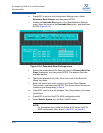
8–Configuring FCoE in a Linux Environment
Boot-from-SAN
FE0254601-00 A 8-29
Figure 8-11. Comparing NPIV Physical and Virtual Ports
Boot-from-SAN
For legacy servers, the most common boot method was to boot from a
direct-attached disk. When booting from direct-attached disk, the server
BIOS/UEFI locates the SCSI/IDE adapter BIOS, which contains instructions that
enable the server to determine which of its internal direct-attach disks is the boot
device. This boot method is called local boot. Local boot is not fault tolerant, nor
does it allow centralized management of operating system images for rapid
deployment scenarios and disaster recovery options. While many modern servers
provide high-availability local disk configurations through server-based RAID
controllers, other issues with local boot are paving the way for alternative boot
methods.
The boot-from-SAN method places the boot device on the SAN—not locally on
the server, as with direct-attached disks. This boot device is a LUN that resides on
a Fibre Channel storage array device. The server communicates with the storage
array on the SAN through a Fibre Channel adapter or a Converged Network
Adapter. The adapter boot code (BIOS or UEFI) contains the instructions that
enable the server to find the boot disk on the SAN.


















